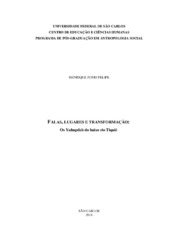| dc.contributor.author | Junio Felipe, Henrique | |
| dc.date.accessioned | 2018-11-08T11:42:15Z | |
| dc.date.available | 2018-11-08T11:42:15Z | |
| dc.date.issued | 2018-03-09 | |
| dc.identifier.citation | JUNIO FELIPE, Henrique. Falas, lugares e transformação: os Yuhupdeh do baixo rio Tiquié. 2018. Tese (Doutorado em Antropologia Social) – Universidade Federal de São Carlos, São Carlos, 2018. Disponível em: https://repositorio.ufscar.br/handle/ufscar/10651. | * |
| dc.identifier.uri | https://repositorio.ufscar.br/handle/ufscar/10651 | |
| dc.description.abstract | This thesis corresponds to an ethnography about the yuhupdeh of the lower Tiquié river, a people belonging to the Nadehup (Maku linguistic family, located in the Amazon Northwest. It is sought to retake here the theme of Maku mobility as the guiding thread of the report that develops in the four chapters of the thesis, understanding it as a characteristic of its sociability, its way of inhabiting the world in relation to its production of knowledge about the world itself. As the ethnographic experience reveals, the yuhupdeh perform a broad movement on the axis from the Serra do Bacurau region, at the headwaters of the Igarapé Ira, home of the Yuhupdeh clans, to the city of São Gabriel da Cachoeira and from there, to the Lake (Rio de Janeiro and other major cities of the country) in the written and photographic records of anthropologists and linguists. It is a pendular movement that coincides with the space-time axis upstream of the trip of the canoe snake, but also around which the cosmos and the yuhupdeh social life are organized. In general, we will try to understand the way in which the yuhupdeh relate their own history, from their appearance in mythical time to the present moment where they are increasingly frequent in the city and have their language and narratives conducted even further, to Rio de Janeiro or São Paulo. In fact, it becomes a focus of interest of the analysis to understand the way the yuhupdeh formulate the transformations in that upstream space-time axis, that is, from Milky Lake to the Serra do Bacurau and, conversely, from Serra to Lake. | eng |
| dc.description.sponsorship | Coordenação de Aperfeiçoamento de Pessoal de Nível Superior (CAPES) | por |
| dc.description.sponsorship | Fundação de Amparo à Pesquisa do Estado de São Paulo (FAPESP) | por |
| dc.language.iso | por | por |
| dc.publisher | Universidade Federal de São Carlos | por |
| dc.rights.uri | Acesso aberto | por |
| dc.subject | Yuhupdeh | por |
| dc.subject | Maku | por |
| dc.subject | Xamanismo | por |
| dc.subject | Paisagem | por |
| dc.subject | Território | por |
| dc.subject | Noroeste Amazônico | por |
| dc.subject | Yuhupdeh | eng |
| dc.subject | Maku | eng |
| dc.subject | Shamanism | eng |
| dc.subject | Landscape | eng |
| dc.subject | Territory | eng |
| dc.subject | Amazon Northwest | eng |
| dc.title | Falas, lugares e transformação: os Yuhupdeh do baixo rio Tiquié | por |
| dc.title.alternative | Talks, places and transformation: the Yuhupdeh of the low Tiquié river | eng |
| dc.type | Tese | por |
| dc.contributor.advisor1 | Andrello, Geraldo Luciano | |
| dc.contributor.advisor1Lattes | http://lattes.cnpq.br/5447074379881029 | por |
| dc.description.resumo | Esta tese corresponde a uma etnografia acerca dos yuhupdeh do baixo rio Tiquié, povo pertencente à família linguística Nadehup (Maku), localizada no Noroeste Amazônico. Procura-se retomar aqui o tema da mobilidade como fio condutor do relato que se desenvolve nos quatro capítulos da tese, entendendo-o como um traço próprio da sua socialidade, do seu modo de habitar e produzir conhecimento sobre o mundo. Como a experiência etnográfica aqui relatada deverá revelar, os yuhupdeh executam um amplo movimento – a pé e de canoa - no eixo que vai da região da Serra do Bacurau, na cabeceira do Igarapé Ira, local de origem dos clãs yuhupdeh, até a cidade de São Gabriel da Cachoeira e dali, até o Lago de Leite (Rio de Janeiro e demais grandes cidades do país) nos registros escritos e fotográficos de antropólogos e linguistas. Trata-se de um movimento pendular que coincide com o eixo espaciotemporal montante-jusante no qual se deu a viagem da cobra canoa que trouxe para a região os povos que hoje a habitam, mas também em torno do qual se organiza o cosmos e a vida social yuhupdeh. De modo geral, procurar-se-á, aqui, apreender o modo como os yuhupdeh relatam a sua própria história, desde o seu surgimento no tempo mítico até o momento atual em que se frequentam cada vez mais da cidade e tem sua língua e narrativas conduzidas até mais distante, até o Rio de Janeiro, São Paulo e grandes cidades brasileiras. Com efeito, torna-se foco de interesse da análise a compreensão do modo como os yuhupdeh formulam as transformações naquele eixo espaciotemporal, ou seja, do Lago de Leite a Serra do Bacurau e, de modo inverso, da Serra ao Lago. | por |
| dc.publisher.initials | UFSCar | por |
| dc.publisher.program | Programa de Pós-Graduação em Antropologia Social - PPGAS | por |
| dc.subject.cnpq | CIENCIAS HUMANAS::ANTROPOLOGIA::ETNOLOGIA INDIGENA | por |
| dc.description.sponsorshipId | FAPESP: 2011/23559-8 | por |
| dc.ufscar.embargo | Online | por |
| dc.publisher.address | Câmpus São Carlos | por |
| dc.contributor.authorlattes | http://lattes.cnpq.br/8293784034457095 | por |
